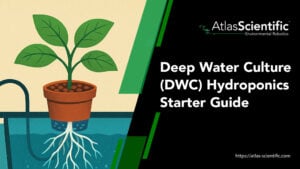Subtotal: $67.99

Deep Water Culture (DWC) Hydroponics Starter Guide
Deep Water Culture (DWC) is one of the most efficient and easiest ways to grow plants hydroponically. In systems such as DWC, plant roots are
Product Categories

We all know the importance of water: this invaluable resource has the power to give life to organisms on earth. This means that if there’s no water, there’s no life! Despite us knowing just how important it is, very few truly understand where it comes from, how we get it, and how we shape it into a completely different product that originally comes from the ground.
Here are some fun fast facts: did you know that 71% of the earth is covered in water? And that only 0.5% of all that water is available for consumption? This small percentage is due to impurities being found in naturally occurring water sources. Since its creation, water has been in contact with many forms of minerals, sediments, and elements for many many many years (think hundreds of millions of years ago). You have probably drunk water that a dinosaur took a hearty swig of so long ago. As you can imagine, it has been mixed with a lot of different stuff! As such, we must somehow remove a large portion of those impurities in order to use water for different applications.
To date, we have invented many forms of purifying water to meet our needs. These techniques have evolved and improved over time, but all have a common theme: getting rid of the pesky minerals and impurities mentioned above. Each technique has its benefits and drawbacks; the right choice all depends on the application and how much money you want to spend on it.
Distillation is probably one of the most well-known and oldest forms of purification. The process is relatively simple: boil water to collect the vapors in a separate container, leaving behind any impurities that did not boil with the water. This process is one of the safest and most effective ways of filtering water, however, it is time-consuming and requires a large amount of heat and energy.
Another form of purification is simple filtration: pass the water through a material that traps and stops any impurities. This is effectively how coffee is made…water is mixed with the coffee ground and is filtered. When done correctly, a delicious substance is produced while the bitter used grounds stay right where they belong.
Chemical treatment is also commonly performed. Did you know chlorine is added to drinking water to disinfect it? Strange concept, but it’s done every day in the water we consume and can be removed.
The final method we will mention is deionization. This technique is relatively newer and involves some pretty fun science. The following article will focus on the science behind it and how we can measure it.
Stemming from the prefix de- which means “off” or “from”, deionization can be thought of as the process of removing ions from a substance. Ions are atoms or molecules with a positive or negative charge. As we already know, naturally occurring water contains many impurities…lucky for us, most of these impurities are effectively ions.
The process of deionization is commonly done by using positively (cationic) and negatively (anionic) charged resins to filter organic and inorganic impurities. These charged resins attract ionically charged minerals and impurities found within water. Think of it as holding a magnet to a rusty piece of iron: the magnet sucks right to that piece of iron and vise versa. Except instead of holding a magnet, you are now submersing a couple of pieces of plastic in a container of dirty (soon to be clean) water. And on top of attracting impurities, these resins spit out H+ and OH– ions that when combined create that coveted H2O.
This technique is used in a wide variety of applications. Scientific laboratories and pharmaceutical companies often turn to deionization due to ions commonly interfering with important solutes and additives, producing misleading data.
Deionization is also an economically wise choice. Compared to other common purification methods, deionization requires only the charged resins and can output purified water quickly and safely. For example, distillation requires constant heat which requires vast amounts of energy and slows throughput. Chemical treatment requires the use of chemicals that can pose a threat to one’s health when stored in large quantities. This method also scales greatly with the amount of water treated, making it another costly investment. Deionization depends only on the quality and size of resin, commonly lasting 5 to 10 years at a time.
Despite deionization being an extremely effective purification technique, even the best baseball and softball infielders let a ground ball slip by now and then. This means one needs a way of ensuring the purity of the water is up to their standard. This standard very much depends on the environment the water is being used in. For example, drinking water will most likely need to be held to a higher standard than water used in a car wash (even though we all love our vehicles like family), and water used in a pharmaceutical laboratory even higher than drinking water. But how can we test that…quantify it even? Well as it turns out, those ions that are filtered by the resins used in the purification process can CONDUCT electricity! This means that the more ions (aka impurities) there are in the water, the more conductive the water will be, and the easier electricity can pass through it. If you want to take a deeper dive into measuring the conductivity of water in general check out this article explaining the science and importance of conductivity in water.
Armed with this knowledge, we can now think of water as a run-of-the-mill electrical wire. I know how that sounded so I’ll repeat it…think of water as an electrical wire. That cord you’re using to charge your phone? That’s water! Okay maybe not exactly water, but you get the point. There are already devices that can measure the amount of electricity (current) passing through a wire and the conductivity of a wire so why don’t we do the same with water?? It sounds crazy but it just might work.

Using a probe that acts similarly to how an ammeter would, and a specialized circuit, the conductivity of a water sample can be easily measured. Shown below is a table of typical conductivity values of different types of water.
| Type | Conductivity (µS/cm) |
| Sea Water (unfiltered) | ~30,000 |
| Lake Water (unfiltered) | ~1,200 |
| Tap Water (Mechanical Filtration, chlorination) | ~550 |
| Deionized WaterUltra-Pure Water | ~0.15~0.055 |
As you can see, the conductivity of the water samples decreases significantly when going down the list from the sea to lake to tap and finally deionized. Starting from a freshwater source such as lake water to the clean product that has resulted from filtration and deionization, approximately 99.9% of particles, minerals, and impurities have been removed. These values were obtained using conductivity probes like those offered by Atlas Scientific.

Armed with these devices, anyone can easily make a quick and accurate reading of the conductivity and ergo purity of water. Atlas Scientific’s conductivity kits make the setup and process even easier by combining the circuits/transmitters, probes, and calibration samples all into one affordable package. These probes have a lifetime of 10 years with calibration only needed once, right at its first use. Atlas Scientific offers models that can measure up to 1 S/cm and some models as low as 0.07 µS/cm. These wide ranges are sure to meet your measurements for the conductivity of deionized water. Seamless in-line solutions make integration that much easier.
Why would the conductivity of deionized water change?
Water can be a fickle substance to clean: it gets dirty very easily, very quickly. In fact, water can grab impurities right out of the air! Measuring conductivity values of water in real-time gives users an immediate idea of the effectiveness of their deionization process. Changes to the conductivity of your deionized water can be a key indicator of unwanted impurities finding their way into your water supply. A sudden increase in conductivity could be the result of a faulty container or piping. For example, rusty pipe that you didn’t know about? Ferrous particles will show up in a major way on a conductivity test. While a more gradual increase in conductivity can often be a sign of degrading or faulty resins in use.
Summary
Water purification has been around for a long time, during that time humans have slowly improved upon these techniques. Factors such as cost, efficiency, and effectiveness have driven us to improve. A product of that improvement has been the invention of deionization.
Deionization is a powerful tool in the fight against the presence of impurities in water. From the use of positively and negatively charged resins, unwanted particles can literally be ripped out of a sample and in return, give water. Seems like a fair trade! But possibly even more important is a way to ensure the deionization process is working or is up to your standards. An instrument as simple as a probe can give you the peace of mind you require.
The experts at Atlas Scientific are here to help you choose the right water conductivity measurement equipment. Any and all questions can be directed to their expert team here.







Deep Water Culture (DWC) is one of the most efficient and easiest ways to grow plants hydroponically. In systems such as DWC, plant roots are

pH drift is a common yet critical challenge in both industrial and laboratory environments, where the pH value moves away from the true, expected pH